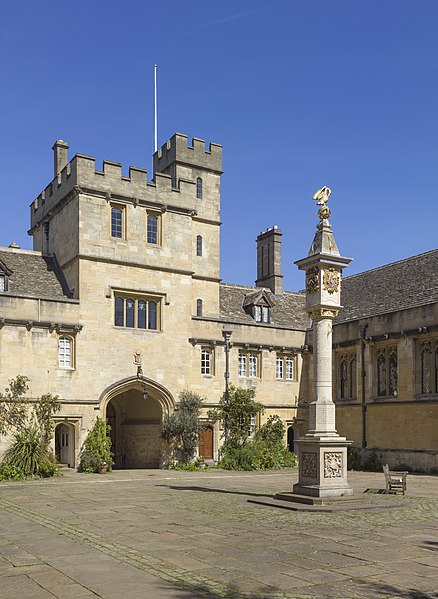Inspector Morse was a highly successful TV
series based on the Chief Inspector Morse novels of Colin Dexter and set in and
around Oxford. The series, which ran from 1987 to 2000, gained
international acclaim for its convoluted story lines and attractive locations,
and international broacasting rights for the series were sold to 200 countries,
making it the most exported TV series in the history of British
television. Viewers worldwide despaired at the behaviour of the irascible
Inspector Morse, played by the late actor John Thaw, with his habit of taking
every opportunity for a drink during the course of his investigations, his
series of thwarted love affairs and his dismissive treatment of those around
him, not least his sidekick the long-suffering Lewis, played by Kevin
Whately.
Inspector Morse was a real ale fanatic, so many
scenes in the series were filmed in Oxford's historic pubs. The Bear Inn
featured in the "Death Is Now My Neighbour" episode in which Morse
visits the pub for a beer during the course of a murder enquiry. In
"The Dead of Jericho", Morse has a drink with a fellow choir member -
one of his many doomed romances - in the White Horse, Broad Street, after choir
practice. The Turf Tavern, an ancient inn nestled among a labyrinth of
narrow lanes, was used in a number of Morse episodes, for example
"The Daughters of Cain". The Eagle And Child (currently closed) – a
favourite haunt of J. R. Tolkien - was visited regularly by Colin Dexter and
also featured in the series.
 | |
| The Eagle and Child (Oxford). Photo by manray3, via Wikimedia Commons. |
Apart from beer, another of Morse's passions is classical music, particularly opera, and as with the ale, this was an
enthusiasm well catered for in Oxford. He is often to be found attending
concerts in the city. In "Twilight Of The Gods", one of Morse's
opera idols, the mezzo-soprano Gwladys Probert, is shot by a sniper.
Earlier in the episode she is seen giving a master-class at the Holywell Music Room. The shooting takes place as a procession is making its way to the
Sheldonian Theatre. This
handsome building, started in 1664, is renowned both for its distinctive
rounded exterior, topped by an eight-sided cupola, and for its beautiful
galleried interior.
 |
| Sheldonian Theatre (5649724219). Photo by Tony Hisgett, via Wikimedia Commons. |
Naturally for a city such as Oxford, many of the
Morse episodes had an academic flavour to them, with the colleges of the
University playing a pivotal role. In "The Last Enemy", the
real identity of the fictional college called Beaumont College was Corpus
Christi College. Morse visits his old friend Sir Alexander Reece at the
college, and Reece asks him to investigate the disappearance of the Deputy
Master. In "The Infernal Serpent" senior fellow of
Beaufort College Dr Julian Dear is attacked and dies of a heart attack.
His funeral, which supposedly takes place at Beaufort College, was
actually filmed in the chapel of University College and in Oriel College.
Oriel College was used in several other episodes, including "Deadly
Slumber", "Twilight Of The Gods" and "Death Is Now My
Neighbour". Lonsdale College is another fictional college which
features in a number of Morse episodes. Brasenose College is the
real-life college which was used to depict Lonsdale, while New College was used
for the fictional St Saviour's.

UK-2014-Oxford-Corpus Christi College 02. Photo by Godot13, via Wikimedia Commons.
Continuing the learned theme,
several of Oxford's museums and gardens have featured in the Morse
series. The title of "The Wolvercote Tongue" refers to a
priceless piece of medieval jewellery belonging to a visiting tourist which
vanishes. An expert on the piece from the Ashmolean Museum, to which the
tourist was going to donate the item, is found dead. In "The
Daughters Of Cain" a knife-wielding murderer steals his weapon from Pitt Rivers Museum. The marksman who shoots Gwladys Probert in "Twilight Of
The Gods" does the evil deed from a vantage point in the Bodleian Library,
the main research library of the University of Oxford, and one of the oldest
libraries in Europe. The adjoining Radcliffe Camera, a beautiful circular building
started in 1737, often appears in the background during Morse's strolls through
the city, for example in "The Last Enemy" when he is seen walking
past it with Lewis. The Botanic Gardens, founded in 1621 under the
auspices of the University, features in "The Settling Of The Sun".
 | |
| Oxford - Bodleian Library - Radcliffe Camera - tree. Photo by Remi Mathis, via Wikimedia Commons. |
The
beauty of the architecture in central Oxford as well as the bucolic countryside
surrounding the city has made it one of south-east England's most used
locations in film and TV productions.
Films made in the city include Shadowlands, a film about C. S. Lewis,
played by Anthony Hopkins, Harry Potter and the Philosopher’s Stone, featuring
the Bodleian Library, X-Men: First Class, which includes scenes shot around the
University buildings, and the 2006 film The History Boys. On the small screen, the series Lewis, a
spin-off from the Inspector Morse series, as well as another about the young Morse called Endeavour, were filmed in and around the city.
Oxford is
a highly cosmopolitan city, where the mix of academic types and the more working
class element has led to the use of the phrase “town and gown”. This mixed population had led to a highly
diverse range of attractions and entertainment, with something for
everyone. The city centre is a jumble of
venerable old colleges, chapels, churches and museums, many open to visitors,
plus a wide variety of restaurants and pubs. Not surprisingly, the city
offers Morse-themed tours of the city.
Or you could just go it alone and go on a Morse-themed pub crawl!
Map of the city.
No comments:
Post a Comment